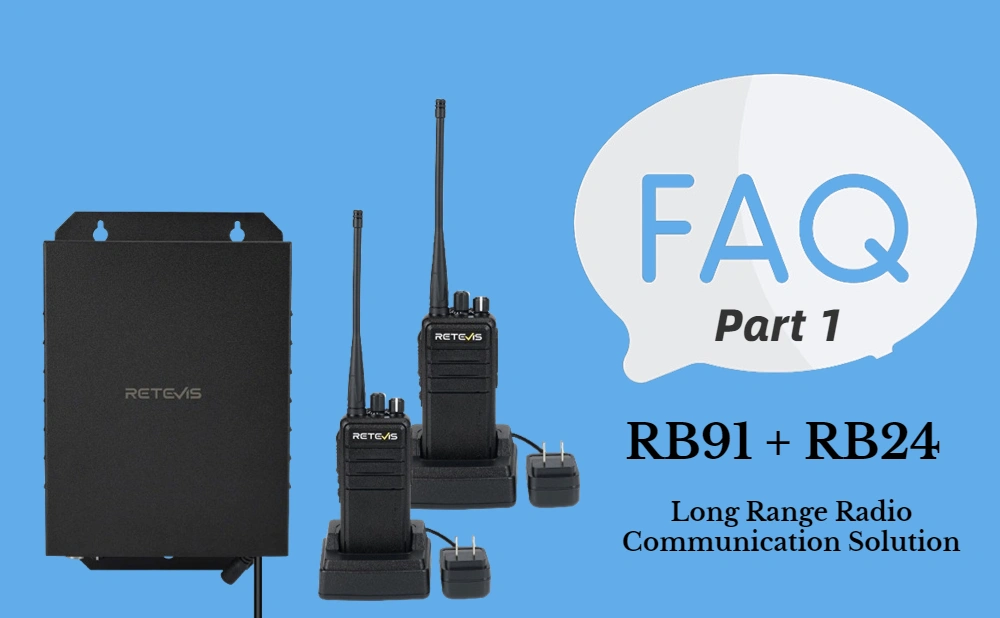FAQs on Retevis RB91 and RB24 Long Range Radio Communication Solution-Part 1

FAQs on Retevis RB91 and RB24 Long Range Radio Communication Solution-Part 1
Retevis RB91 digital repeater with RB24 digital handheld radios is a long range radio communication solution that is specifically designed to overcome communication issues in closed environments. In this article, we will address six frequently asked questions about this long distance communication solution, and provide useful installation tips of RB91 digital repeater.
 RB91 LoRa Repeater + RB24 Digital Handheld Radio
RB91 LoRa Repeater + RB24 Digital Handheld Radio
6 Frequently Asked Questions On Retevis RB91 and RB24
1. How do RB91 and RB24 communicate with each other?
The automatic pairing function is set at the factory. Adjust the RB91 repeater and RB24 digital handheld radio to the same channel, and then they can communicate with each other directly. (NOTE: The RB24 handheld radio is only compatible with the RB91 repeater.)
2. What is the benefit of RB24's 30-level jump/automatic networking function?
Regardless of power, digital radios have a limited range. However, the Retevis RB24 handheld digital radio comes with a repeater function, can automatically form a network, and can continuously connect up to 30 radios to extend the communication range, solving the issue of talking in closed environments.
3. What are the battery capacities of the RB91 and RB24?
The RB91 base station has a 15000mAh large-capacity battery to provide a standby time of 7 days and a working time of 10 hours. This ensures that the base station can be used throughout the day without the need for frequent charging. In addition, the Retevis RB91 repeater also supports solar charging via a 12V (solar) charging port. RB24 has a built-in 1300mAh battery, which supports up to 29 hours of standby and 10 hours of working time, effectively meeting the whole day's work.
4. What is LoRa and how does it work?
LoRa is short for “Long Range”. LoRa modulation scheme is a modulation technique combined with a data encoding technique that gives a broad-band spread-spectrum radio the receive sensitivity of a very narrow-band long range radio.
LoRa techniques give LoRa receivers unprecedented sensitivity levels. LoRa radio modems can receive signals 10 times weaker than most radios. When a receiver’s sensitivity is increased by 10 times, that is the same communication range improvement as increasing the transmitter power 10 times. Both the RB91 repeater and the RB24 digital radio have a built-in LoRa (Long Range) modulation and feature long-distance communication and low power consumption.
5. What are the factors affecting the communication distance?
Communication distance is impacted by many factors, including antenna installation, power, receiving sensitivity, obstacles, etc. However, RB24 handheld radios support connection to 30 radios, which extends the range and coverage compared to other two-way radios.
6. How to install the RB91 base station?
RB91 is a wall-mounted repeater that is simple to install. Just use the equipped screws and hole to hang on the wall.
Tips for the Installation of RB91:
1. Avoid Electromagnetic Affection Source: Avoid being close to sources of strong electromagnetic fields, such as high-power radio transmitting stations, radar stations, high-voltage transmission lines, etc. These may produce severe electromagnetic effects on the normal operation of relay equipment.
2. Reduce Physical Obstacles: The installation location should try to avoid high-density buildings, large metal structures (such as elevator shafts and reinforced concrete walls), mountains, high-rise buildings, etc. These obstacles will block or attenuate wireless signals.
3. Avoid Same Frequency Interference: Other wireless devices using the same or similar frequencies, such as other wireless walkie talkie repeaters, wireless devices, etc., may cause co-channel affection. Frequency resources need to be planned appropriately to avoid overlap.
4. Stay Away From Water Source and Humid Environment: Avoid installing directly near water sources, such as water towers, lakes, rivers, etc., and places with high humidity to reduce the risk of equipment corrosion and short circuits caused by moisture.
5. In An Appropriate Temperature: The repeater should not be installed in places where the temperature is too high or too low. Extreme temperatures may cause performance degradation or damage to electronic components. Ensure that the repeater operates within the appropriate temperature range specified by the manufacturer.
6. Protection from Lightning: For repeaters installed outdoors, consider lightning protection measures to avoid direct lightning strikes and appropriate grounding methods to prevent induced lightning currents from damaging the equipment.
Thank you for reading this blog! If you have any questions, please leave your comments below. We are looking forward to your comments!
Related Blog: FAQs on Retevis RB91 and RB24 Long Range Radio Communication Solution-Part 2






